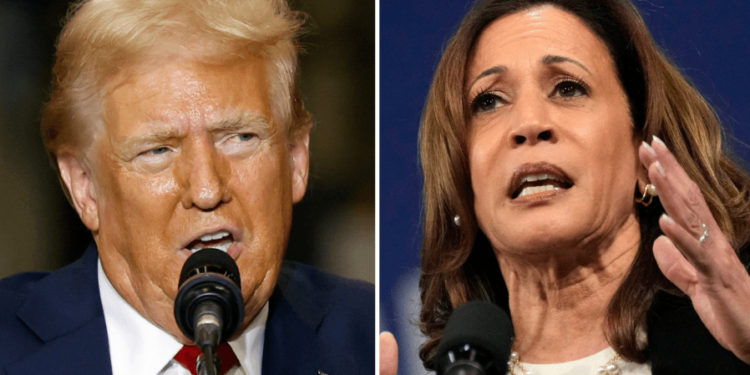
A new estimate finds that former President Trump’s tax and spending plans could add twice as much to the national debt as those brought by Vice President Harris, amounting to more than $7 trillion over the next decade.
The rough analysis released by the Committee for a Responsible Federal Budget (CRFB) on Monday estimated the plans proposed by both candidates could increase the national debt by trillions of dollars through 2035.
In assessing the potential fiscal impact of the candidates’ plans, the CRFB produced a central cost estimate for both sets of proposed policies, along with low-cost and high-cost estimates.
When looking at their central estimate, the budget watchdog found Harris’s plans could add $3.5 trillion to the national debt over the next decade, including about $500 billion in interest costs. By contrast, the group estimated a $7.5 trillion boost to the national debt when measuring the impact of Trump’s plans, including about $1 trillion in interest costs.
The numbers change drastically when looking at the group’s low-cost and high-cost estimates.
Under the low-cost estimate, the group said Harris’s plans “would not add to the debt.” However, under the high-cost estimate, her plans could increase projected debt by more than $8 trillion through fiscal 2035, the group found.
Trump, on the other hand, would “increase projected debt by $1.45 trillion through FY 2035 under our low-cost estimate and by $15.15 trillion under our high-cost estimate,” the analysis stated.
The Hill has reached out to both campaigns for comment.
The most expensive measure highlighted by the group is an estimated $5.3 trillion price tag attached to Trump’s proposals to extend and modify parts of his signature 2017 tax law. Harris’s proposal to extend some parts of that plan would also cost almost $3 trillion from 2026-35.
The next largest item for both candidates in the analysis are their proposals to reduce individual taxes and expand tax breaks.
The analysis also looked at the costs of lower business taxes, policies to restrict immigration and boost border security, as well as increases to some housing-related spending and tax breaks.
The committee said the analysis will be updated as more policies are rolled out in the coming weeks. However, it also notes a “high degree of uncertainty” will be attached to its estimates as questions swirl around key details of both candidates’ economic proposals.
The group “relied on candidate statements, campaign feedback, past budget proposals, and other sources for enough detail to credibly estimate the potential costs or savings and in most cases have produced wide-ranging estimates that reflect many different potential policy choices.”
The national debt now stands at more than $35 trillion, and recent analysis projects that, without major changes, the debt will continue to rise as a share of the economy in the coming years.
“Under our central estimates, we find that Vice President Harris’s plan would push debt to 133 percent of GDP in FY 2035 – an 8 percent of GDP increase,” the group said Monday. “We estimate President Trump’s plan would push debt to 142 percent of GDP in 2035 – a 17 percent of GDP increase.”







